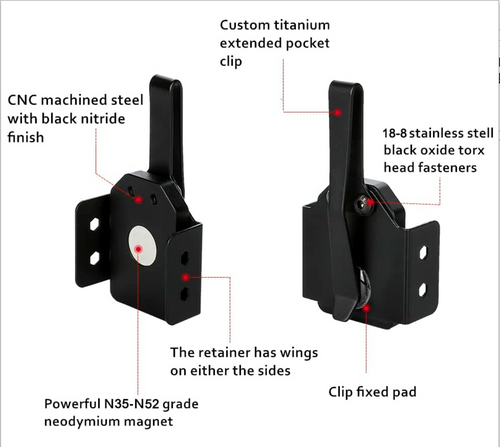Mistakes in drawing a concealed firearm can slow you down, compromise safety, and hurt accuracy when it matters most. Here’s what you need to know to avoid common errors and improve your technique:
- Top Mistakes: Choosing the wrong holster, improper garment clearance, poor muzzle direction control, and bad trigger discipline.
- Key Fixes: Daily dry fire practice, selecting a secure and comfortable holster, and training under stress.
- Why It Matters: Errors can delay response, increase safety risks, and reduce accuracy in critical moments.
Quick Tip: Use a reliable holster, such as the Houdini Holsters Breakout 2.0, to ensure consistent, safe draws. Pair this with regular practice and expert training to refine your skills.
Want to improve your concealed carry draw? Start with the right gear, practice daily, and train for real-world scenarios.
Common Mistakes Drawing From Concealment
Common Draw Mistake: Wrong Holster Choice
Using the wrong holster can slow down your draw and create safety risks. It impacts both how securely your firearm is held and how quickly you can access it. For instance, the Houdini Holsters Breakout 2.0 IWB holster, with its patent-pending design, offers a snug fit and dependable retention for smooth, consistent draws.
Here are some key factors to consider when choosing a holster:
| Consideration | Impact on Performance |
|---|---|
| Retention Level | Determines draw speed and firearm security |
| Material Quality | Affects durability and ease of use |
| Weapon Fit | Ensures safe handling and consistent draws |
| Positioning Options | Influences accessibility and concealment |
A good holster should securely hold your firearm without making it hard to draw. It should also stay in place during daily activities, helping you build the muscle memory needed for quick, safe draws.
Choosing the wrong holster can lead to slower reactions and increased safety concerns, which we’ll explore further in the next section.
sbb-itb-7fb5bb8
Effects of Draw Mistakes
Mistakes during a firearm draw can lead to more than just delays. They can create risks that impact both safety and effectiveness in a concealed carry situation.
Slower Response Time
A poor draw technique - such as failing to clear your garment properly - can slow down your ability to access your firearm when it matters most.
Safety Risks
Errors in the draw process can lead to serious safety issues, including:
- Muzzle Direction Control: A bad draw can cause the muzzle to unintentionally point at unintended targets, increasing the risk of harm.
- Trigger Discipline: Rushing or using improper technique might lead to placing your finger on the trigger too early, raising the chance of an accidental discharge.
- Equipment Issues: Using a holster that doesn’t fit well can make the draw awkward, increasing the likelihood of mishandling the firearm.
These problems not only put safety at risk but can also reduce shooting effectiveness.
Reduced Accuracy
Mistakes like a poor grip or awkward movements during the draw can throw off your sight alignment and weapon control, ultimately hurting your accuracy.
For example, the Houdini Holsters Breakout 2.0 IWB holster is designed to support a smooth, consistent draw, helping you maintain proper technique under stress.
How to Fix Draw Mistakes
Improving your draw technique requires consistent practice, attention to detail, and the right gear to ensure speed, safety, and precision in concealed carry.
Daily Dry Fire Practice
Dedicate 10–15 minutes each day to practicing key elements of your draw:
- Grip: Ensure you establish a proper grip right from the holster.
- Garment Clearance: Work on smoothly clearing your cover garment.
- Sight Alignment: Keep your sights aligned throughout the draw.
- Trigger Discipline: Keep your trigger finger indexed along the slide until ready to fire.
Always double-check that your firearm is unloaded and practice in a safe direction with a reliable backstop.
Choose the Right Holster
The holster you use plays a major role in your draw efficiency and safety. Look for a holster that offers:
- Secure weapon retention
- Full trigger guard coverage
- All-day comfort
- Quick and consistent access
- A proper cant angle for your carry position
Master Trigger Control
Refine your trigger control with these steps:
- Keep your finger straight and indexed until you decide to fire.
- Apply steady, consistent pressure during the trigger pull.
- Practice efficient trigger resets between shots.
Practice Under Stress
Training under pressure can help you perform better in real-life situations. Incorporate these drills into your routine:
| Training Method | Objective | How to Implement |
|---|---|---|
| Timer Drills | Track improvement | Start with 2-second par times, then lower them as you improve. |
| Physical Exertion | Simulate adrenaline | Perform 20 jumping jacks before drawing. |
| Low Light Practice | Prepare for low visibility | Practice in different lighting conditions. |
| Multiple Targets | Enhance decision-making | Train with multiple target setups. |
Pair these drills with professional coaching for the best results.
Get Expert Training
Working with a skilled instructor can take your skills to the next level. Look for:
- Certified firearms instructors with concealed carry experience
- Small class sizes to ensure personalized attention
- Courses covering both basic and advanced draw techniques
- Regular feedback to refine your mechanics
An experienced instructor can offer tailored advice on grip, movement, and gear, helping you achieve a smoother and safer draw.
Conclusion
Mastering your concealed carry draw requires precise technique and the right gear. Research shows that mistakes in clearing your garment or mishandling the trigger can slow your response and jeopardize safety - both of which are critical in high-pressure situations.
To improve, focus on three key areas: regular practice, reliable equipment, and expert instruction. Incorporating daily dry fire drills into your routine can help minimize errors and sharpen your skills, making you more prepared when it matters most.
Having dependable gear is just as important. The Houdini Holsters Breakout 2.0 IWB holster, known for its patent-pending design, ensures secure retention while allowing quick access - proving that the right equipment plays a vital role in safe and efficient draws.




